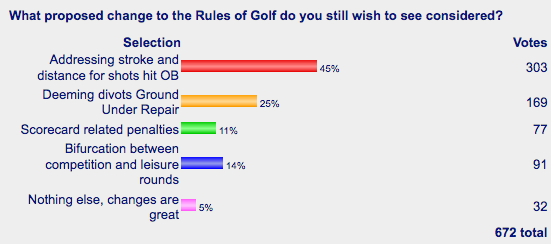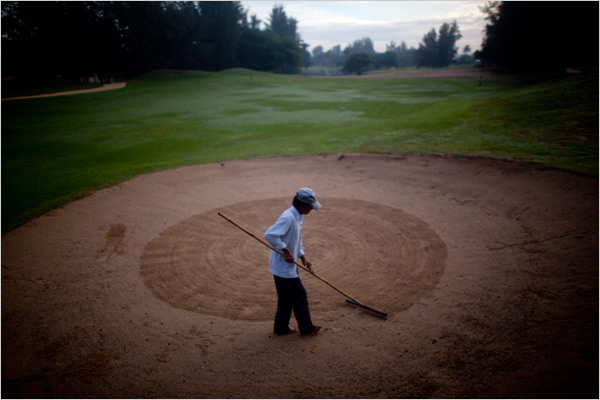Well, you didn't quite get your wish(es). But golf has a new task force working group. Hooray for Hollywood!
So let's review. In the wake of Chapter 32 of Television-Fueled Rules Controversies, we all pretty much agree that golf does not need at home-officiating or scorecard penalties assessed at a later time (but never after the final round).
Your votes:
 For the 46 who voted for reasonable judgement, ding ding, you win!
For the 46 who voted for reasonable judgement, ding ding, you win!
However, in theory, maybe, quite possibly, I think, should the player's word supersede that of the video evidence going forward, then this should eliminate retroactive penalties for signing an incorrect scorecard. Sorry Dustin, Anna and Lexi, you were ahead of your time. You're still penalized.
At-home officials appear to be neutralized by today's Decision, but not eliminated from wreaking havoc. However, with social media's ability to team up against a player using video evidence, a case could be made that we will still have player demonized by video evidence. So good luck, Lance, Tommy, Tom R, Loomy, Brandt and the other producers who have to sort out what to show and what not to show.
Here's the press release:
New Rules of Golf Decision Limits Use of Video Review
USGA and The R&A Prioritize Working Group to Assess Role of Video
in Applying Golf’s Rules
FAR HILLS, N.J., USA AND ST. ANDREWS, SCOTLAND (April 25, 2017) - The USGA and The R&A have issued a new Decision on the Rules of Golf to limit the use of video evidence in the game, effective immediately.
A Decision as we are trying to get rid of Decisions. Kinky!
The two organizations have also established a working group of LPGA, PGA Tour, PGA European Tour, Ladies European Tour and PGA of America representatives to immediately begin a comprehensive review of broader video issues, including viewer call-ins, which arise in televised competitions.
More meetings!
New Decision 34-3/10 implements two standards for Rules committees to limit the use of video: 1) when video reveals evidence that could not reasonably be seen with the “naked eye,” and 2) when players use their “reasonable judgment” to determine a specific location when applying the Rules. The full language of the Decision can be found here.
Happy reading. Hope you have a law degree.
Instead, the USGA's Thomas Pagel explained it better to Golf World's Jaime Diaz:
“We are trying to make sure that players that are on television are not held to a higher standard than others playing the game,” said Thomas Pagel, the USGA’s senior director of rules.
“Television evidence can reveal facts that as a human being you could not reasonably have known in the playing of the game. A player could do everything he or she could to get it right, but video evidence could still show that they got it a little wrong. And the only reason we can know they got it a little wrong is because we’ve been able to slow down, pause, rewind, replay, all the things that the player on the golf course doesn’t have the advantage of doing.”
This will appease those of us who see the Lexi Thompson situation fitting here, but will not satisfy those who believe she was up to something nefarious (concluded after watching the zoomed in, slowed down replay many times...the next day).
Though as Beth Ann Nichols notes here for Golfweek, it's also not clear if Lexi's situation would have ended differently given today's news, but it seems fairly obvious that the Johnson and Nordqvist boondoggles would be avoided going forward.)
Back to the press release:
The first standard states, “the use of video technology can make it possible to identify things that could not be seen with the naked eye.” An example includes a player who unknowingly touches a few grains of sand in taking a backswing with a club in a bunker when making a stroke.
Anna!
If the committee concludes that such facts could not reasonably have been seen with the naked eye and the player was not otherwise aware of the potential breach, the player will be deemed not to have breached the Rules, even when video technology shows otherwise. This is an extension of the provision on ball-at-rest-moved cases, which was introduced in 2014.
The second standard applies when a player determines a spot, point, position, line, area, distance or other location in applying the Rules, and recognizes that a player should not be held to the degree of precision that can sometimes be provided by video technology. Examples include determining the nearest point of relief or replacing a lifted ball.
So long as the player does what can reasonably be expected under the circumstances to make an accurate determination, the player’s reasonable judgment will be accepted, even if later shown to be inaccurate by the use of video evidence.
Both of these standards have been extensively discussed as part of the Rules modernization initiative. The USGA and The R&A have decided to enact this Decision immediately because of the many difficult issues arising from video review in televised golf.
Fascinating that Lexi's situation forced action, not the two 2016 incidents at USGA events which now might turn out differently under today's Decision.
The standards in the Decision do not change any of the current requirements in the Rules, as the player must still act with care, report all known breaches of the Rules and try to do what is reasonably expected in making an accurate determination when applying the Rules.
Right, right, right, now let's get to the golf!
Video-related topics that require a deeper evaluation by the working group include the use of information from sources other than participants such as phone calls, email or social media, and the application of penalties after a score card has been returned.
But first, we have to decide if we are meeting at Sea Island, Pinehurst, Pebble or Bandon to hash this call-in stuff? Maybe Sand Valley? It's on the way to Erin Hills! Sort of.
Here are the harrumphs...including this endorsement from the LPGA Tour.
USGA Executive Director/CEO Mike Davis said, “This important first step provides officials with tools that can have a direct and positive impact on the game. We recognize there is more work to be done. Advancements in video technology are enhancing the viewing experience for fans, but can also significantly affect the competition. We need to balance those advances with what is fair for all players when applying the Rules.”
Martin Slumbers, Chief Executive of The R&A, said, “We have been considering the impact of video review on the game and feel it is important to introduce a Decision to give greater clarity in this area. Golf has always been a game of integrity and we want to ensure that the emphasis remains as much as possible on the reasonable judgment of the player rather than on what video technology can show.”
The USGA and The R&A will consider additional modifications recommended by the working group for implementation in advance of Jan. 1, 2019, when the new code resulting from the collaborative work to modernize golf’s Rules takes effect.
The proposed Rules are now definitely taking effect January 1, 2019?
Maybe with the speed of this helpful Decision perhaps it's time to discuss moving the implementation date up?
Decisions, decisions.
 This is a topic we've been hearing rumblings about for about a month now, though I wasn't sure the governing bodies were serious. Today's statement suggests they are very concerned about the impact these have on skill, something confirmed by the USGA's Mike Davis when I spoke to him at The Masters.
This is a topic we've been hearing rumblings about for about a month now, though I wasn't sure the governing bodies were serious. Today's statement suggests they are very concerned about the impact these have on skill, something confirmed by the USGA's Mike Davis when I spoke to him at The Masters.



















